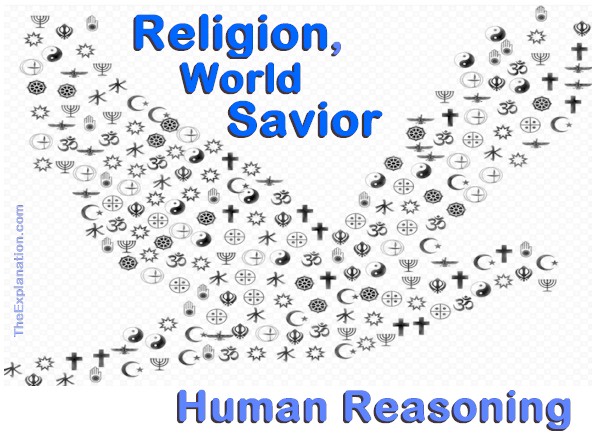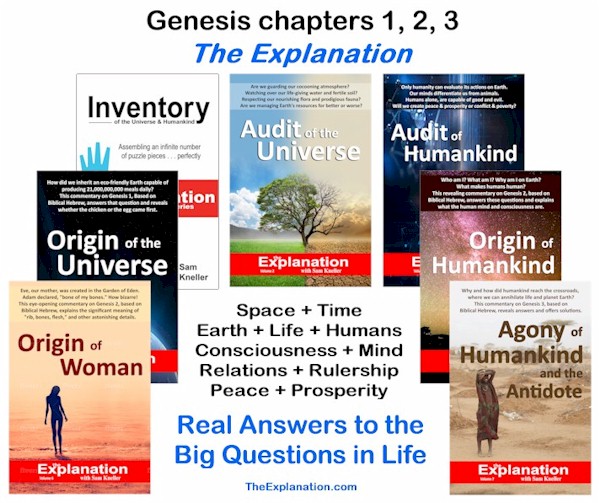Religion is believed in or practiced by 85% of the world’s population. It is one of the most prevalent universal common denominators. Yes, it’s fractioned, but all supposedly believe in love and compassion. Why can’t religion usher in world peace?

Religion is it the world’s savior? This is how many humans reason.
Religion is present in the four corners of Earth (so to speak). Proportionately, if you had a village of 1000 people, you’d have 314 Christians, 232 Muslims, 150 Hindus, 71 Buddhists, 67 other religions, 2 Jews and 164 agnostics and atheists. Clearly, religion is a driving force of humankind. Despite the rise and influence of science and the insights it has discovered about our physical world, the metaphysical runs off as winner of the race for human minds.
(Audit of Humankind, chapter 5.13)
In the context of The Explanation, where we’re looking for a solution to establish world peace, can religion in general offer solace? Whether it’s religion in general or a particular religion? Do their beliefs and practices reflect a pathway to peaceful living?
Let’s start by defining religion focusing on the concept of this final section of this final chapter of Audit of the Universe. How humankind reasons. The fundamental reasoning of religion is that there exists some supernatural power.
We’ve discussed personal experience, philosophy, and science and how they propose to institute world peace. They all believe in the preeminence of humankind and our ability, of and through the human mind to find the way to world peace. They do not believe in or resort to any solution coming from any other source than human intelligence.
Religion is the only one of the four reasoning patterns that believes exactly the opposite. Religion is anchored in the belief that there’s some extra-human, in the sense of outside the human realm, that really controls the world, the universe, in short, the destiny of humankind. This is the realm of the spiritual. It is invisible, immeasurable, impenetrable to most mortals. Hence, very challenging to apprehend.
Looking, a little closer at our 1000 village population let’s quickly differentiate the metaphysical reasoning of the various groups. I’ve already discussed philosophy and shown why, in fact, Hinduism and Buddhism are part of that thought pattern and not considered religions. Revise the meaning of Buddhahood and its sister philosophical counterparts as the goal for Eastern spirituality. We know they have and worship G/gods but this was not the original intention of their founders.
Many groups and beliefs could be discussed. The Explanation is specifically interested in how they plan to bring about world peace. There are basic belief systems that we might include in religion that do not broach this subject. One such heteroclitic group is Animism. They believe that everything, people, rocks, rivers, the sky and indeed the universe, have spirit and soul.
That this is the link between all living and non-living entities that should be respected. Although fairly widespread there is no concerted proposition to reach a goal of world peace and prosperity. This might be considered a religion since it has supernatural leanings but would also fit into a more philosophical way of life.
Agnostics and atheists fall into one or more of the first 3 thought patterns so they’ve already been discussed. We are not discussing Churches per see in this section. Churches may be considered as buildings, groups of believers, or religions. This can range from the Satanic Church to Social Church to Atheist mega Churches. These religions, if we can call it that, have an agenda. Often, they are set up as a reaction against some considered ill in society. Other groups promote healing, speaking in tongues or miracles. Again, these are focused on smaller (maybe important) issues, not on reflection about global peace and prosperity issues. They do represent a sliver of human reasoning.
That leaves us with Christianity, Islam, other religions, and Judaism. Other religions cover a plethora of religious beliefs that would need a library of books to detail and would include, among many others, Mormons, Seventh Day Adventists, Jehovah Witnesses, Christian Science… Of course, Christianity is just as fractioned with over 40 thousand colors. There are various Islam schools of thought and diverse movements in Judaism.
The commonality of all these groups, although there are exceptions, is they are what we call Abrahamic faiths. They believe they are descendants of the patriarch Abraham of the Bible. This could be actual physical descendants or spiritual adherence to the Abrahamic line. Abraham was an Old Testament (Hebrew Bible) figure of capital importance because of being chosen by God. He was the key participant in a covenant with God that establishes him as the father of the faithful. These faithful of all human peoples, as the story goes, are the spiritual descendants in the various Christian, Islamic, Jewish and other religious organizations that exist today.
Sacred books and the Bible in Religion
Personal experience and philosophy are grounded in human reasoning. Science is founded on human discoveries of physical phenomena. The major difference with religious thought is the origin of its basic texts. For religion, these texts are revealed by non-human, spiritual, sources. Although recorded by human beings, these messages are considered inspired by an external superior subject. Most often referred to as God. In some religions, it can be Gods, god or gods. Whatever it’s called, it is spiritually superior to humans. It certainly is not human, which causes the number one problem for science. It is not provable.
The Bible is probably the key principle text for most Abrahamic faiths. We will get into a deeper discussion of human reasoning about the Bible in the next few posts. Know that there are questions about inspiration, revelation, transmission, and canonization of these sacred texts. In a nutshell, how can we be sure they are authentic?
How can we ascertain whether to take them literally or figuratively or both? Should we interpret them in function of their historical, cultural setting or not? (Here’s an interesting excerpt about concordism in a book The Lost World of Genesis 1 by John Walton. He claims you cannot make Genesis conform to the modern understanding of Cosmology. Read pages 16-17 from the Look Inside excerpt) Often times there are narratives where no human was present (at Creation or for prophetic Revelations). How valid can that be?
Another major issue that arises as to the basis of these texts for human reasoning to reach peace and prosperity is what’s added to the Bible or other sacred texts. I’m referring to additional texts (Apocrypha, Dead Sea Scrolls, and later works like the Koran or Book of Mormon or commentaries by Ellen G. White or Maimonides).
Then there’s the additional issue of the role tradition plays in religion. If it’s human tradition, then another pattern of human reasoning filters into religion and how to reach peace and prosperity. For instance, Catholicism has the magisterium which gives authority to the highest clerics to interpret the Word of God in the largest sense of the term, whether in its written form or in the form of Tradition. The Immaculate Conception and Assumption of Mary by Popes Pius IX and XII are such examples.
Catholicism, Islam, and Judaism all devote considerable authenticity and authority to oral tradition, passed down by word of mouth over the generations and finally recorded. The question can be asked, is this divine revelation or human addition? The Protestants do not take this tradition into account in their doctrinal approach.
For an extremely important part of the world’s population, the human reasoning process foundation is religion, sacred texts, and religious tradition. In major swaths of religion human adaptation, via traditions, has crept into the comprehension of spiritual texts. Can this fourth method of human reasoning, religion, assemble our puzzle of peace and prosperity perfectly?
This blog post is an excerpt from chapter 5.13 of Audit of Humankind.
Dig Deeper into The Explanation
Online Study Courses to Uncover the Mystery of Adam and Eve’s Nakedness… with no fuss. Free video mini-course revealing the God-intended meaning of Scripture via Biblical Hebrew. It’s so easy, it’ll blow you away. Join now and add new motivation to your Bible study.
Join The Explanation Newsletter to stay informed of updates. and future events. No obligations, total privacy, unsubscribe anytime, if you want.
The Explanation series of seven books. Free to read online or purchase these valuable commentaries on Genesis 1-3 from your favorite book outlet. E-book and paperback formats are available. Use this link to see the details of each book and buy from your favorite store.

Since you read all the way to here… you liked it. Please use the Social Network links just below to share this information from The Explanation, Religion – Is it the Solution to World Peace?



Trackbacks/Pingbacks